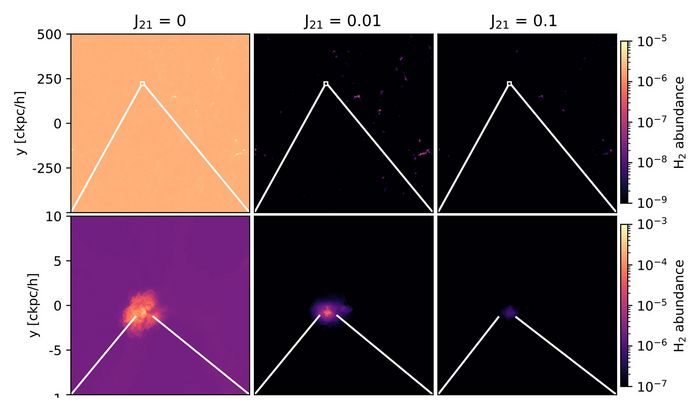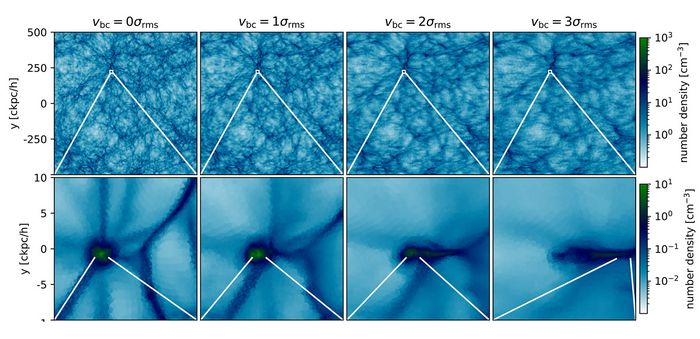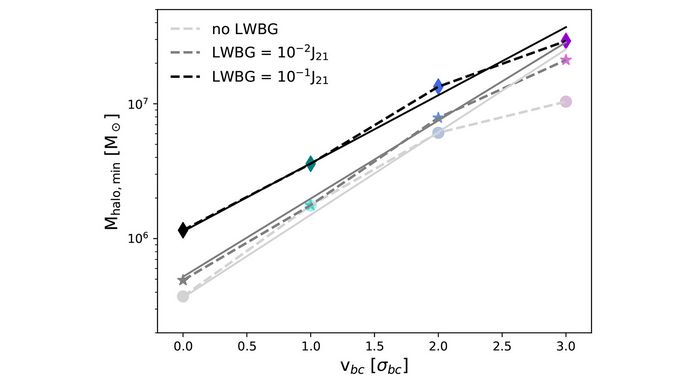ASTROPHYSICS
Delaying First Star Formation
Principal Investigator:
Anna Therese Phoebe Schauer
Affiliation:
Zentrum für Astronomie, Universität Heidelberg
Local Project ID:
pr53ka
HPC Platform used:
SuperMUC and SuperMUC-NG of LRZ
Date published:
Introduction
The formation of the first stars in the Universe marks a critical transition in cosmology: before these so-called Population III stars formed, all gas consisted of hydrogen, helium, and trace amounts of lithium. Higher elements are bread in stars, and elements such as carbon or oxygen that are fundamental for life on Earth, only ceased to exist after the formation period. In addition, the star formation process is also dependent on these elements, as gas clouds need to radiate their energy (heat) away in order to collapse and form stars. Molecular hydrogen plays a key role in the early Universe to enable star formation, as it can cool a gas cloud down to temperatures of a few hundred K. It is therefore important to include the chemical network into calculations of the sites of first star formation.
We also know the structures in which stars are forming in the present-day Universe: galaxies. At early times, these galaxies were much smaller, with masses of 105-107 solar masses instead of 1011 solar masses in galaxies such as our Milky Way. These tiny early galaxies are named minihalos and consist of one population – Population III stars. The properties of minihalos are actively researched, such as the chemical composition of the gas, the spin, shape or mass. These details help understand when and where the first stars are able to form.
Two large-scale effects further influence the formation of Population III stars in the early Universe: a Lyman-Werner background and streaming velocities. Lyman-Werner radiation can photodissociate molecular hydrogen, the critical molecule for gas cooling and therefore star formation. Streaming velocities describe the large offset velocity between the gas and dark matter component originating back to recombination. Regions of the Universe of a few Mpc are exposed to the same velocity offset value. Both effects are known to increase the halo mass in which stars are forming, and because larger halos assemble later than small halos, the formation of Population III stars is globally delayed.
Results and Methods
With the support of computing resources on SuperMUC and SuperMUC-NG of LRZ over the past years, our team has achieved to demonstrate, for the first, that streaming velocities and Lyman-Werner radiation add onto each other and both increase the halo mass necessary for first star formation. Both effects also add up to delay the formation of first stars. We have further shown that streaming velocities are the dominant component in doing so.
This research was only possible using the large computational power of SuperMUC and SuperMUC-NG. In our set of large hydrodynamical simulations, we investigated for the first time how the two effects interplay. We have run twelve cosmological simulations to probe all combinations of no streaming velocities and 1, 2 and 3 sigma, as well as no and a Lyman-Werner background of 0.01 and 0.1 J21. For each simulation, we followed the interactions of 10243 dark matter particles and gas cells each, not only treating the gravitational interaction, but also the fluid dynamics and the chemical composition of the gas. Highly-parallel processors were necessary to carry out these computations.
The effects of streaming velocities can be seen in the picture below, which we created using our simulation data at redshift z=15.
This figure shows the effect of streaming velocities on the gas number density. From left to right, the streaming velocity value increases from 0 to 3 sigma. In the top row, a slice through the whole simulation box can be seen. On this large scale, one can see that the density structure gets washed out, leading to a reduced density contrast and maximum density when zooming into a minihalo (bottom row).
In the second figure, we show how a Lyman-Werner background can influence the formation of stars by reducing the molecular hydrogen abundance.

© Anna T. P. Schauer
Globally, the fraction of molecular hydrogen is reduced by several orders of magnitude, as low-density gas cannot self-shield from Lyman-Werner radiation. This can be seen in top panel of the second figure, where we show a slice through the whole simulation box for increasingly large Lyman-Werner backgrounds (left to right). At the center of a minihalo (bottom row), the molecular hydrogen abundance is generally larger, and even regions with a Lyman-Werner background are able to retain some molecular hydrogen, however to a much smaller extent. Star formation is therefore hindered, as molecular hydrogen is key to gas cooling at high redshift.
For the combination of both effects, streaming velocities and Lyman-Werner radiation, we find them to add up onto each other. We further quantify our results by calculating the minimum and average halo mass necessary for the formation of Population III stars in a minihalo. The results can be seen in the third figure below, where we show the minimum halo mass for star formation as a function of streaming velocity for all Lyman-Werner background strengths explored in our set of simulation. We further fit an analytic function to our data, allowing our simulation results to be used for semi-analytic modelling.
On-going Research / Outlook
While the main project – determining the properties of the typical minihalo – is completed, there are several ongoing projects based on the data produced with SuperMUC and SuperMUC-NG. Another molecule, hydrogen-deuteride, can cool a gas cloud to even cooler temperatures, and we will be able to investigate its contribution to Population III star formation. Our comprehensive data set further allows us to investigate whether star formation in streaming velocities can be linked to globular clusters, potentially solving an over hundred year old mystery of the Universe. For creating our unique, large dataset, SuperMUC and SuperMUC-NG has been indispensable for this forefront research.
Preprint of the main simulation paper: https://ui.adsabs.harvard.edu/link_gateway/2020arXiv200805663S/arxiv:2008.05663 (accepted by MNRAS)
Research Team:
Anna Schauer1 (PI), Ralf Klessen1, Simon Glover1, Paul Clark2
1Zentrum für Astronomie, Universität Heidelberg
2School of Physics and Astronomy, Cardiff University
Scientific Contact
Dr. Anna Therese Phoebe Schauer
now at: University of Texas at Austin
Department of Astronomy
2515 Speedway, Austin, TX 78712 (USA)
e-mail: anna.schauer [@] utexas.edu
Local project ID: pr53ka
July 2021

